The best four-engine seaplane of World War II
On March 5, 1942, the morning silence of the island of Oahu in Hawaii was torn apart by explosions aviation bombs. The Americans were extremely puzzled, since the Japanese aircraft carriers were at that time far away, and none of the known Japanese bombers were able to reach the islands from the nearest base and return. Only towards the end of the war it became clear that the bombing of Hawaii was the debut in the military career of the new Japanese flying boat N8K1 of the company Kawanishi Kokuki K.K.
The last shots of the Japanese battleships, which ensured Japan's victory over the Russian fleet Tsushima, as a new enemy appeared in front of the Land of the Rising Sun - the USA. The Americans by all means demonstrated their readiness to defend the interests of their capital in China. In 1907-1909, the American battleships carried out their famous campaign of the "Great White Fleet" following the tragic path of the squadron of Admiral Rozhestvensky. In the opinion of US President T. Roosevelt, this campaign was to make it clear to the Japanese that the US fleet is not Russian "self-propelled weapons", but a force designed to dominate the Pacific Ocean.
However, the challenge thrown by the Americans only spurred samurai fighting spirit and naval construction in the Island Empire. Having identified the United States as their main adversary since 1908, Japan began preparing for the inevitable battle. Naturally, the Japanese admirals realized that the United States is economically superior to the Land of the Rising Sun, and in addition, the Washington 1920 Maritime Conference of the Year set the ratio of battleships between these countries as 3: 7 in favor of the United States. The way out was found in the creation of new types and classes of naval armaments, which were not subject to contractual restrictions. In this case, perhaps, the Japanese paid the closest attention to a new kind of naval armaments - aviation. Starting in the twenties with the purchase of licenses for the production of German, British and American cars, by the time of entry into the war, Japan had the best deck fighters in the world, diving bombers, torpedo bombers. The coastal aviation of the fleet was equipped with torpedo bombs with a record range, and the heavy strike and reconnaissance flying boats had no equal in the complex of their combat characteristics until the end of the war. The latter were built on the Kavanishi company under the designation H8K, and the Americans subsequently assigned them the codename "Emily".
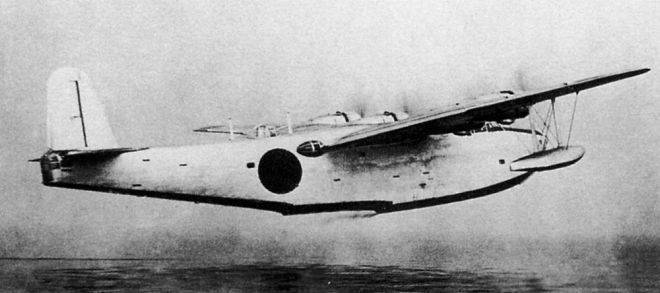
An order to create a large seaplane capable of conducting long-range reconnaissance with a cargo of bombs, the leadership of Kavanishi received back in August 1938, when the first Catalina and Sunderland began to arrive in service with US and British aircraft. Therefore, the main requirement for the new aircraft was its superiority in speed, range and combat load over the flying boats of a potential enemy. In addition, the lone scout required the ability to independently defend itself against possible fighter attacks and to withstand combat damage well.
The team of designers under the leadership of Shizuo Kikuhare received a difficult task, since the boat with all the high technical requirements had to have a maximum speed of 445 km / h and a range of 8400 km. In order to achieve such data, it was decided to abandon the “parasol” scheme, according to which the previous hydroplanes of the company were carried out, and to develop the boat as a four-engined monoplane with an upper wing.
Originally planned to perform underwing float retractable, but then abandoned it, believing that you should not complicate and weight the structure because of a small gain in speed. To improve the takeoff and landing characteristics, double-slotted flaps were used. Fuel supply reached 17040 L, which was almost 30% of the maximum take-off weight. Gasoline was stirred in unprotected wing tanks and fuselage tanks with a neutral gas system. On the plane was applied the original system to increase survivability. When shooting the fuselage fuel tanks, located under the center section of the wing, gasoline flowed into the sealed bottom of the fuselage, and from there pumped into undamaged tanks.
When choosing engines, they stopped at the 14-cylinder two-row air-cooled Mitsubishi MK4А “Kasei” 11, the take-off power of 1530 l. with. with four-blade Sumitomo screws with a diameter of 3,4 and. Two torpedoes of 800 kg or up to 2000 kg of bombs (2x800 kg, or 8x250 kg, or 16x60 kg) could be suspended on pylons between engines. The defensive armament consisted of two 20-mm guns of the 99 type, located in the aft and upper turret turrets, as well as four 7,7-mm machine guns of the 92 type (two-in-one turrets and one in the side blisters behind the rear edge of the wing).
The design of the aircraft was all-metal. The fuselage is double-decked. For the movement of the boat on land provided for the installation of removable chassis carts. The crew consisted of a 11 man: a commander, two pilots, a navigator, a flight engineer, a radio operator, and five gunners.
The assembly work on the first machine was completed at the Kavanishi plant near Osaka 29 on December 1940, and the next day the crew under the command of Hiromitsu Ito began test flights. Despite the rebalanced rudder, overall controllability as a whole turned out to be quite acceptable, which could not be said about the hydrodynamic characteristics of the aircraft.
In the very first departures, problems arose with water splashes that, when taxiing even at low speeds, fell onto the screws (there were even cases of bending of the blades) and into the air intakes of the carburetors. Surprise was the desire of the boat to bounce at the speed of separation ("pounding"). It was possible to cope with jumping after the test pilots found that increasing the angle of attack on 4-5 degrees eliminates this unpleasant phenomenon.
To fight the fan of the spray, we had to carry out a series of tests on models in the pool, after which the boat returned to the factory for modifications. Changes were made to the shape of the bottom of the fuselage, and special longitudinal ridges that act as spray absorbers were riveted on the front sides. Carburetor air intakes were moved to the top of the engines, and 25 March 1941, the first aircraft was officially transferred to the aircraft of the Imperial Navy.
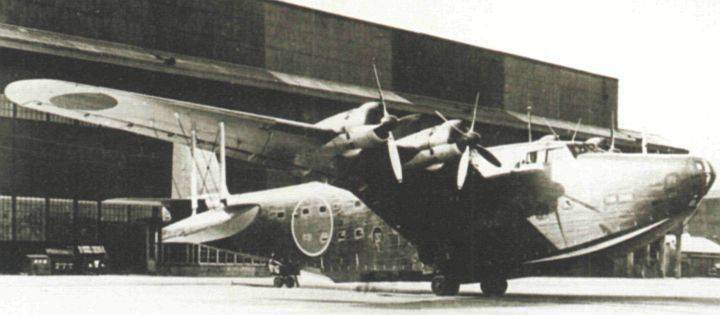
All changes are taken into account on the other pre-production machines. In addition, they were extended to 1 and 30 by the cm of the fuselage nose, they installed a modified rudder and replaced the engines with MK4B “Kasey” 12 (of the same power, but with a more advanced exhaust system). The PVD boom in front of the cockpit windshield (on the first boat the boom was elsewhere) caused special marks, and the pilot, combining them with the horizon line, maintained the necessary angle of attack, preventing the aircraft from bouncing on the water during takeoff. Wing gas tanks became protected.
All four pre-production cars were prepared for use in February 1942, when the aircraft received the official designation - the flying boat Kavanishi H8K1 Type 2 Model 11. The Americans, who were not familiar with the subtleties of Japanese aviation casuistry, came up with a much simpler notation for enemy aircraft. Fighters were given male names, and to bombers and generally multi-engined vehicles - female ones. In accordance with this system, a huge four-engine seaplane dubbed a beautiful name - "Emily".
By that time, Japan was already fighting with the US in the Pacific, launching their 7 on December 1941, striking aircraft from aircraft carriers at Pearl Harbor. But, despite the losses suffered by the US Navy, Pearl Harbor remained the main Pacific base of US ships. For aviation reconnaissance and bombing of the harbor by the command of the Japanese fleet was developed "Operation K". The main role in it was assigned to new flying boats of the Kavanishi company, for which participation in the operation became a baptism of fire.
The H8K1 range was 7200 km, but this was not enough, since the distance from the nearest Japanese Votye air base on the Marshall Islands to Pearl Harbor was 3700 km one way in a straight line. The only way out was to refuel the planes. But how? Intermediate aerodromes did not exist, and refueling in the air on H8K1 was not provided. The decision came unexpectedly - to use submarines as tankers. And three submarines - I-15, I-19 and I-26 - with a supply of aviation gasoline went to one of the desert atolls, located in 925 km north-west of Hawaii, where the meeting with the aircraft was to take place. One more boat, the 9, halfway to Pearl Harbor, played the role of a repeater in radio communications.
In “Operation K” they planned to use three hydroplanes, but during landing on the Marshall Islands they damaged the winged float on one of the cars, and since there was no time to repair, they had prepared the two remaining aircraft for the flight. Vice-Admiral Inoy, the commander of the 4 air fleet, personally spoke with the pilots and selected the two best crew commanders, Lieutenants Hashizume and Tomano.
4 March 1942, at midnight, two large shadows flashed in the dark and headed for Hawaii. The Japanese hoped to use the US weather report over Oahu. But just a few hours before departure, the Americans changed the cipher of radio communications, and the crews of hydroplanes could only count on luck.
After more than eighteen hours, the boats safely fell down at the meeting point, where submariners were already waiting for them. On the thrown hoses pumps quickly drove gasoline into the empty tanks. Each aircraft received 11360 liters of fuel. After waiting for the middle of the night, they continued their ultra-long route. Two hours later, both flying boats were above the target, but the dense clouds did not allow reconnaissance, and the bombs had to be thrown blindly. Without causing any harm to the enemy, the boats returned to the base. "Operation K" ended in complete failure.
Three months later, the crew of Hashizume attempted to reach the Midway Atoll in the same way, but was spotted with a radar and shot down by Buffalo fighters. In accordance with the experience of operating the first sixteen serial machines, the command of the Navy demanded a further increase in combat survivability. The crew members' armchairs were protected by six millimeter armor points. Gone casters on rifle turrets appeared. Installed new powerful engines with water injection system - MK4Q "Kasei" 22 for 1850 l. with., and in the nose turret installed 20-mm gun.
The designers improved the rudder, and at the bottom of the fuselage a small keel was installed for better stability and controllability of the aircraft on the water. Maximum take-off weight increased to 32,5 t. The use of new engines significantly improved the performance of the aircraft. The maximum speed reached 455 km / h, the flight altitude increased from 7630 to 8780 m, and the take-off distance decreased from 411 to 295 m.
More powerful engines require more fuel, so the H8K2 Type 2 Model 12 (as the new version became known in June 1943 year) without refueling, could fly by 780 km less, although the capacity of the fuel tanks compared to the first cars increased by 1840 l. For the most distant flights have provided the ability to install additional tanks in the fuselage.
This modification of "Emily" has become the most numerous - built 122 aircraft.
After commissioning, Kavanishi H8K2 until the end of the war remained a flying boat with the most powerful caliber defensive armament. This forced the American pilots to respect the aircraft, especially since his vitality was excellent. The pilots of the United States were convinced of this themselves, when, having spent the entire ammunition, they were surprised to see that the Emily was flying, as if nothing had happened.
The first connection, which received H8K2, was the same aviation unit in Yokohama. By the way, in July 1942, two Н8К1, having flown from Yokohama to Rabul (island of New Britain), carried out reconnaissance and bombardment of various targets on the islands of Fiji, New Caledonia and New Hebrides. By that time, six H8K1 serials entered service with a squadron in Yokosuka, and they all participated in sabotage operations on the Aleutian Islands in June 1942.
Designers are constantly making changes to their favorite offspring. At Н8К2 the number of 20-mm guns was brought to five, the wing was strengthened and the plane was equipped with a locator, the antennas of which were placed on the nose. To increase the speed, they decided to return to the original idea: to make the wing floats retractable. Two serial machines equipped with hydraulic cylinders for cleaning the floats and a sliding upper turret. All these tricks gave an increase in speed of only 10 km / h, and the planes remained in duplicate, having received the H8KZ index. At the beginning of 1945, the engines were changed to them on the MK4T “Kasei” 25 with direct fuel injection, and the cars began to be called H8K4. The first of the vehicles was lost on 1 in March 1945 of the year, carrying out reconnaissance flight, and the second was shot down in 10 days when searching for naval targets for kamikaze pilots during the landing of the American landing force on Iwo Jima Island.
One of the modifications was the transport version of the aircraft. In November, 1943, the very first H8K, was rolled into an assembly hall and reequipped, dismantling the upper turret and side blisters with firing points, making windows in the fuselage and placing a passenger seat on two 41 decks. The boat received the poetic name H8K1-I "Asahi" (Morning Star). Subsequently, it was joined by the last of the four pre-series H8K1, equipped with 27 passenger seats, but the series launched an aircraft based on the H8K2 calling the H8K2-L machine "Seiku" (Cloudless Sky). In the 1944 and 19945, the Japanese assembled 36 hydroplanes in a transport version.
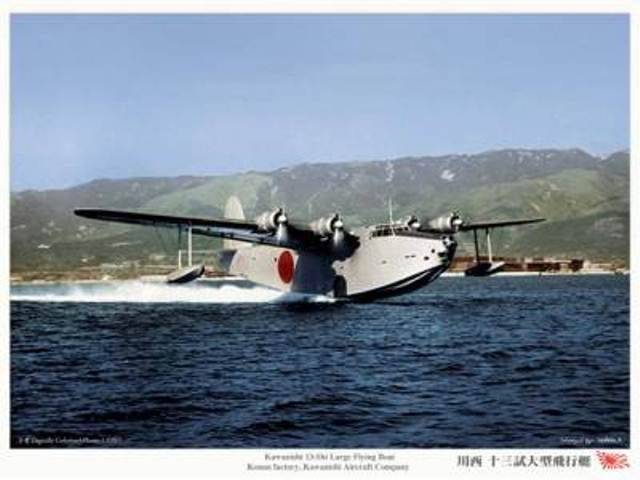
The peak of the H8K2 production was reached in 1943, when they rolled out 6-7 machines every month. Thirty-one aircraft H8K2 managed to assemble by the middle of 1944-th, but then forced the urgent need for fighters to give the production capacity of the company Kavanishi for their release. An exception was made only for the H8K2-L transporter, whose production ended by the spring of the 1945. In total, the 167 H8K was produced, much less than the English Sunderland or American Catalin, but the Japanese boat throughout the war proved to be one of the most prominent naval aircraft in the world.
Performing many flights on boats in the dark did not always save from encounters with Yankee night fighters, as the Americans began to equip their aircraft with locators. In response, the Emily pilots tried to use this trick: as soon as the American fighter entered the flying boat on the radar, it began firing, the pilots put their aircraft on the wing, and the change of mark on the screen simulated the shooting down of a Japanese aircraft. But this cunning of the Yankees soon got to the core, and the number of Emily destroyed in aerial combat grew, which led to the disbanding of the 802-KU air unit in April, and 851-KU in November 1944. The only connection that did not suffer major losses was the 801-Ku part.
18 March One of the flying boats, taking off from Okinawa, found American ships 185 kilometers east of the island of Tanegashima, but a few hours later was shot down. On the same day, the two other "Emily" Americans destroyed on the water during mooring off the island of Kosa. In the next two days, another five H8K2 fell into the sea after uneven air battles, and two boats sank in the parking lots as a result of attacks by American aircraft.
Operation Gen-Ichi-Go at the beginning of April, 1945, in which Kawanishi flying boats attacked US ships, warning the landing of Americans on the Japanese islands, became the last episode of the combat use of these aircraft.
In the last six months of the war in the Pacific, the imperial fleet has lost twenty-five of the surviving twenty-eight flying boats. 15 aircraft were shot down in air battles, 2 boats crashed while landing after damage and 8 sank at their anchorages after air attacks.
The three remaining cars were captured by the Americans; having the opportunity to get acquainted with an interesting plane. US aviation specialists highly appreciated the merits of Emily, considering it one of the best hydroplanes of the second world war.
One H8K2 Americans overtook in Norfolk and subsequently were going to exhibit it as an exhibit at the National Aviation Museum. True, for such a large aircraft, it was not immediately able to find a place, especially since in the summer of 1960, a hurricane damaged a car standing in the air, and considerable funds were needed for its restoration. But then the Japanese showed great interest in the aircraft, since by that time it was already the last instance of a flying boat. At home, Emily, under the leadership of psychology doctor Saito and artist Fuyuhito Okabe, created an ad hoc committee to return the aircraft, and after long negotiations with the US government in July 1979, the unique flying boat returned to the Land of the sun.
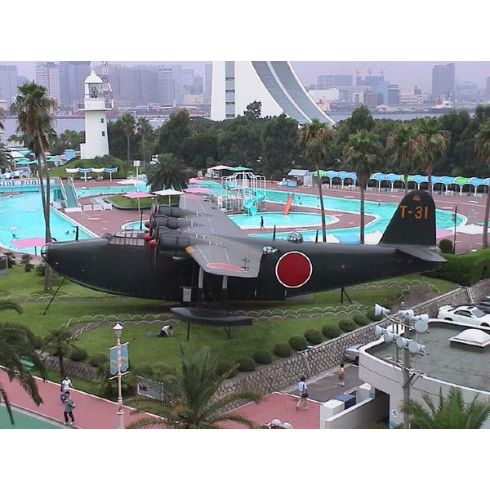
After restoration, the flying boat Kavanishi H8K2 Type 2 Model 12 took its place in the Museum of Marine Science in Tokyo, recalling the time when it was not equal among military seaplanes in the vast Pacific.
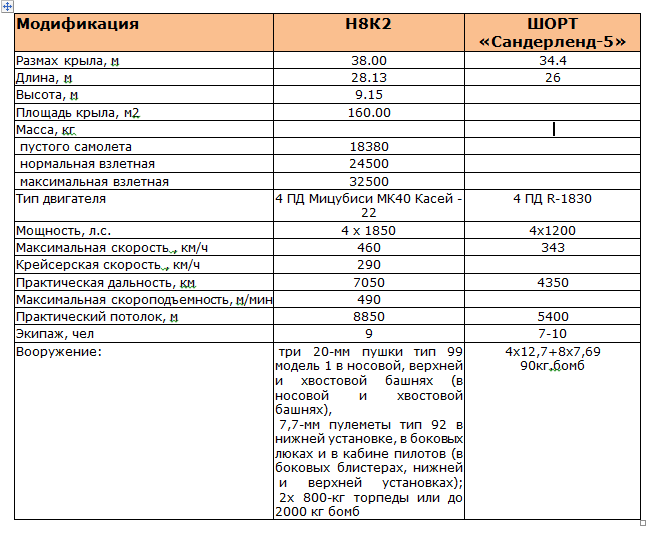
Sources:
Firsov A. Kavanishi Н8К // Aviation Collection No. XXUMX. 4. C. 1996-4.
Doroshkevich O. Kawanishi H8K // Japanese planes of World War II. Harvest. Minsk. 2004. C. 318-322.
Kolov S. Kavanishi Н8К // Wings of the Motherland. 1995. No.6. C. 18-19.
Kotelnikov V. Seaplanes 1939-1945. // Model builder. Special edition. 2003. No.2. C. 84-85.
Kolov S. Marine intelligence officer "Mavis" // Planes of the world. 1996. No.2. C.32.
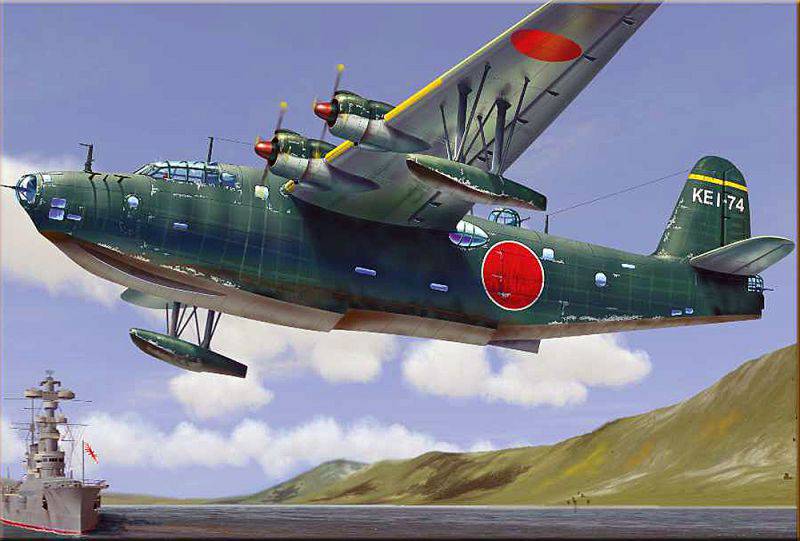
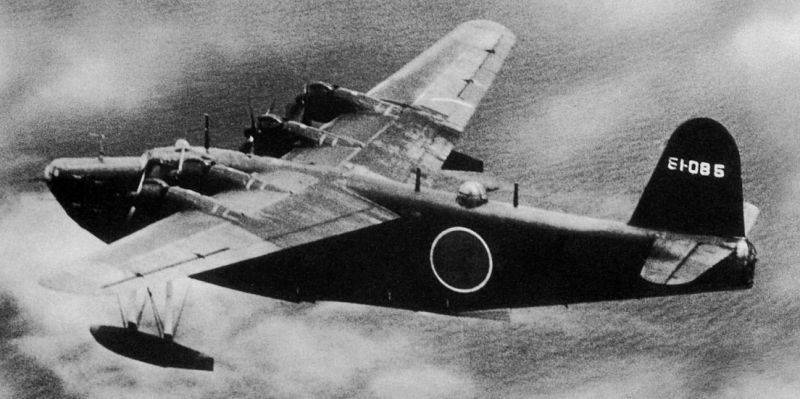
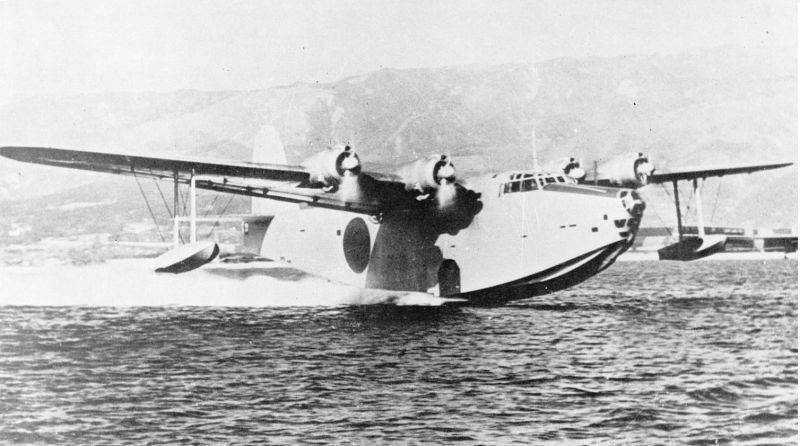
Information